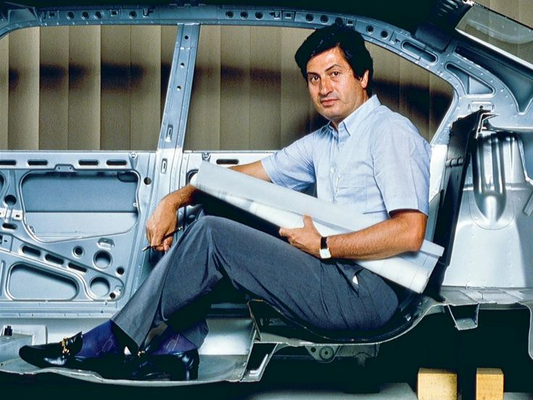The Vector W8 is one of the most fascinating and unique supercars in automotive history. Designed by American engineer and designer Gerald Wiegert and produced between 1989 and 1993 by Vector Aeromotive Corporation, the W8 embodied the American ambition to compete with European giants such as Ferrari and Lamborghini in the high-performance sports car arena. Its futuristic lines, innovative technology and impressive performance have made this car a cult object, despite its rarity and the controversies that surrounded its production.

Photo credit: https://www.pinterest.fr/pin/462674561739932273/
Background and Design
The creation of the Vector W8 was part of Gerald Wiegert's dream to build an American supercar that would combine exceptional performance, cutting-edge technology and breathtaking design. Before the W8, Wiegert had already worked on a prototype called the Vector W2 in the 1970s, but the W8 is the commercial culmination of that.

Vector W2 / Photo credit: https://en.wikipedia.org/wiki/Vector_W2#/media/File:VectorW2silver.jpg
The Vector W8 immediately stands out for its bold look, inspired by fighter jets and aerospace technology, a heritage reflected in its corporate name "Vector Aeromotive". The angular, low body, with its sharp edges, large air intakes and composite panels, gives it an almost alien appearance. It looks like a car straight out of a science fiction film, a look ahead of its time, but also perfectly suited to the futuristic trends of the time.
Mechanical Performance: A Beast Under the Hood
Under the hood of the Vector W8 lies a real beast: a 6.0-liter twin-turbo V8, based on a Chevrolet engine, capable of producing up to 625 horsepower and a monstrous torque of 880 Nm. Thanks to this powertrain, the Vector W8 could reach a claimed top speed of around 390 km/h, although in real conditions it was limited to around 350 km/h, which is still incredibly fast, especially for the time.

Photo credit: https://www.pinterest.fr/pin/128141551877765764/
The 0 to 100 km/h sprint was dispatched in around 3.9 seconds, figures that put the W8 in the same category as the most powerful European supercars of its time, such as the Ferrari F40 or the Porsche 959. But what made the Vector W8 particularly unique was its marriage of raw power and technology. It was equipped with advanced electronic systems and components from the aerospace industry, such as Kevlar and aluminum body panels, high-performance brakes and electronic turbo management.

Photo credit: https://www.pinterest.fr/pin/60728294961707235/
An Interior Inspired by Aeronautics
The Vector W8's interior was just as impressive as its exterior, continuing the aeronautical theme with a digital instrument panel and controls worthy of an airplane cockpit. Screens displaying various driving information, multiple buttons and switches, everything in this cabin was designed to make the driver feel like they were piloting a machine from another dimension.

Photo credit: https://www.pinterest.fr/pin/568298046722285584/
The interior design, although criticized for its complexity and sometimes difficult to grasp ergonomics, reinforced the high-tech and exclusive side of the W8. Leather, Alcantara and other high-end materials add a touch of luxury to this futuristic-inspired environment.
Limited Production and Rarity
One of the most striking aspects of the Vector W8 is its rarity. Due to high production costs, financial problems, and the technical complexity of the car, only 19 examples of the W8 (plus two prototypes) were built between 1989 and 1993. This has helped make this supercar particularly desirable among collectors and exotic car enthusiasts.
The low production volume, combined with a reputation for being a difficult car to master, has made the Vector W8 a cult model. Despite its rarity, it has made several media appearances, including in films and music videos, which has helped to reinforce its image as a futuristic exotic car.
Financial Problems and End of the Adventure
Unfortunately, Gerald Wiegert's dream of making Vector a world-renowned supercar brand faced considerable financial and industrial challenges. Production of the W8 was marred by delays and exorbitant costs. Wiegert's lofty ambitions clashed with market reality, and the company faced several internal crises, including an attempted takeover by foreign investors.
In 1993, production of the Vector W8 was stopped, and the brand sank into obscurity, despite an attempt to revive the company with the Vector M12, a model powered by a Lamborghini engine, but which never achieved the same success or the mythical aura of the W8.

Vector M12 / Photo credit: https://www.pinterest.fr/pin/743516219760524699/
Heritage and Worship
Although the Vector W8 was produced in very small quantities, its impact on the automotive industry is undeniable. It remains one of the few American supercars to have challenged the European giants with a certain technical success, although commercial constraints prevented the brand from prospering. Today, the Vector W8 is extremely sought after by collectors, and the rare examples that appear on the market reach astronomical prices.
The Vector W8 symbolises an era where audacity, technological innovation and the dream of a purely American supercar converged. While Vector Aeromotive’s journey may have ended prematurely, the legend of the W8 continues to fascinate, making it one of the most iconic and enigmatic supercars of all time.

Photo credit: https://www.pinterest.fr/pin/418905202851634744/




